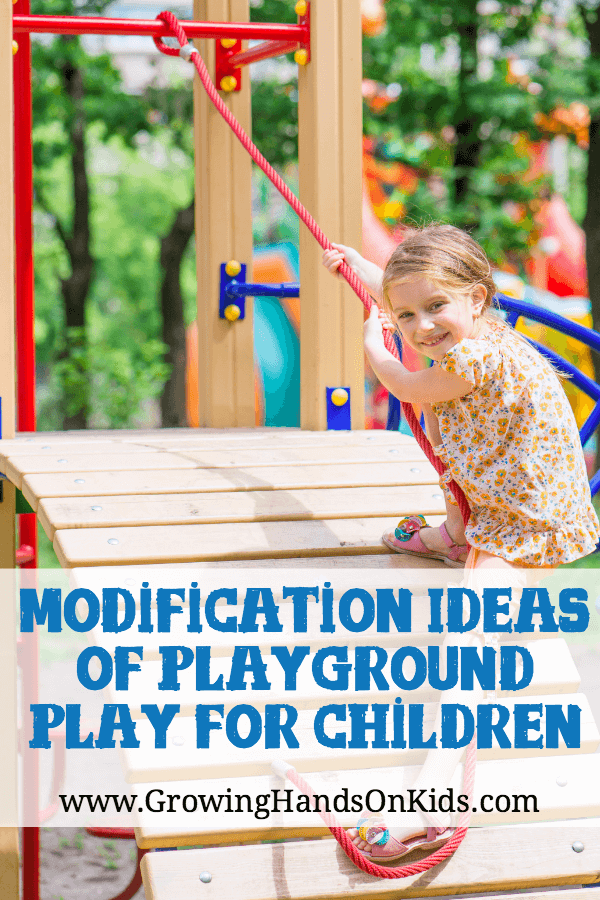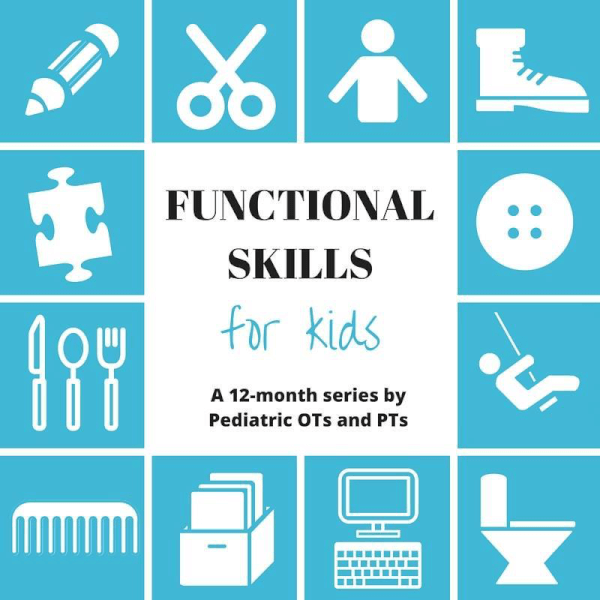Modification Ideas of Playground Play for Children
Affiliate and Referral links are used below to promote products I love and recommend. I receive a commission on any purchases made through these links. Please see my disclosure policy for more details. As an Amazon Associate, I earn from qualifying purchases.
Playgrounds are usually a very popular activity among younger and school age children. My daughter always asks to go to the park and she loves checking out new playgrounds in the area. For some children however, playing on a typical playground can be challenging because of special needs, sensory processing concerns or developmental delays. I am teaming up with some therapy bloggers today to discuss playgrounds and I will be sharing some modifications of playground play and equipment for children.
Benefits of Play and Playgrounds
Playground play is a very important part of a child's development for many reasons. It helps to develop their emotional, cognitive, physical growth.
Here are just a few skills that children develop through play and on playgrounds:
- Waiting in line
- Taking turns
- Initiating and Sustaining conversations
- Accepting help from others
- Listening
- Accepting feedback
- Follow directions
- Play by mutually agreed upon rules
- Expression of feelings
- Connection to self
- Having fun and feeling happy
- Sense of failure
- Determination
- Trial and error
- Problem solving skills
These are just a few of the many skills children need to develop in order to be successful. Playing on a playground is so important for building these skills. For children with special needs or developmental delays, being able to access playgrounds can be a challenge, especially if it is an older playground.
In 2010, the Americans with Disabilities Act standards required that all playgrounds meet the requirements for accessibility for those with disabilities. If you have been to many newer playgrounds, you will probably notice more accessible areas.
In 2012, the ADA was amended to specify that certain percentages of ground level and elevated play equipment must be accessible. Unfortunately, many older playgrounds have not complied due to funding and cost issues.
What are some ways we can encourage accessibility for all? With a range of special needs ranging from physical to emotional, cognitive and sensory processing needs, playgrounds need to be able to appeal to all these different groups.
Things to Keep in Mind for Modifications of Playgrounds
Here are some key things you need to keep in mind when modifying or looking for a playground that can fit your child's needs:
- What environment support is needed?
- What materials need adapted?
- Do certain activities need to be simplified?
- Is any special equipment needed?
- What adult, peer or invisible/naturally occurring support is needed?
There are also four main play areas to consider in a playground:
- Is your child able to participate in climbing activities?
- Are they able to use overhead equipment?
- Are swings accessible for those with physical needs?
- Are sand or water play areas accessible for all?
One important area that you may not think about until you have to is access to the playground itself. Many of the older playgrounds include railing or tight spaces to get in and out of the playground area. This makes it harder for those in wheelchairs or with walkers to gain access to the playground. Make sure there is an area large enough for a wheelchair to be able to pass through as well as safely turn around with enough room and also a safe surface.
Other things to consider:
- Swings that can be used with a wheelchair and/or high back swings that give support to those with poor trunk control and balance.
- Access to overhead equipment such as monkey bars or pull up bars from a wheelchair level.
- Areas that include shade and or quieter spaces for those who need to retreat from noise and commotion.
- A variety of ramps, bridges, and stairs to those with varying gross motor skills
Resources for Modified or Adaptive Playground Equipment
Some items you may want to consider adding or modifying in a school, therapy or home playground setting include:
- ADA ramps
- Special Needs Swing Sets (those for wheelchairs and high back swings for trunk support)
- ADA picnic tables
- Safety mats
- ADA Sandbox diggers
- Accessible water and sand tables for those in wheelchairs
- Wheelchair accessible and free standing ladders for pulling and climbing
- ADA spring riders
- ADA basketball goals
Here are some very helpful websites and/or online stores that provide different modified and adaptive equipment for playgrounds and group play.
- Landscape Structures
- Game Time – Inclusive Playground Products
- Special Needs Playground Equipment
- Playcraft Systems
- AAA State of Play
Developmental Progression of Playground Skills | Your Therapy Source
Promoting Fine Motor Skills at the Playground |Miss Jaime OT
Modification Ideas for Playground Equipment for Children | Growing Hands-On Kids
Playground Games and Activities for Kids | The Inspired Treehouse
Essential Social Skills To Survive the School Playground! | Your Kids OT
Developing Visual Skills and the Playground | Therapy Fun Zone
Resources:
“Accessible Play – Creating Playgrounds that Welcome All Abilities.” Playlsi. https://www.playlsi.com/en/playground-planning-tools/plan-your-playground/accessibility
Allsop, M. “The Engagement of Children with Disabilities in Health-Related Technology
Design Processes.” Disability and Rehabilitation: Assistive Technology 5 (2010):
1-13. Article.
Brisco, Leigha R., “Designing and Evaluating Playground Equipment for Compliance with the Americans with Disabilities Act” (2014). Honors Theses. Paper 18. http://ecommons.udayton.edu/uhp_theses/18/
Duerr Evaluation Resources. “The Benefits of Playgrounds for Children Ages 0-5.” Research Paper. 2001. www.duerrevaluation.com.
“Information and Technical Assistance on the Americans with Disabilities Act.” www.ada.gov.
Ray, Tip. “What is Play?” 2006. Discover Leisure Education, The Trustees of the University of Illinois. www.indiana.edu. 5 March 2013.
“Public Playground Safety Handbook” U.S. Consumer Product Safety Commission. 2015. http://www.cpsc.gov/
Sandall, Susan R. “Play Modifications for Children with Disabilities.” Beyond the Journal. 2003.

Heather Greutman, COTA
Heather Greutman is a Certified Occupational Therapy Assistant with experience in school-based OT services for preschool through high school. She uses her background to share child development tips, tools, and strategies for parents, educators, and therapists. She is the author of many ebooks including The Basics of Fine Motor Skills, and Basics of Pre-Writing Skills, and co-author of Sensory Processing Explained: A Handbook for Parents and Educators.



NIce post Heather! I love seeing all the new design features in new playgrounds for kids of different abilities now. Designers are getting really creative which I love!
I love your list of skills that children can develop at the playground. Children need to get outside and play. These are some great suggestions for children who need modifications so they can participate with their peers!
Thanks Jamie! 🙂